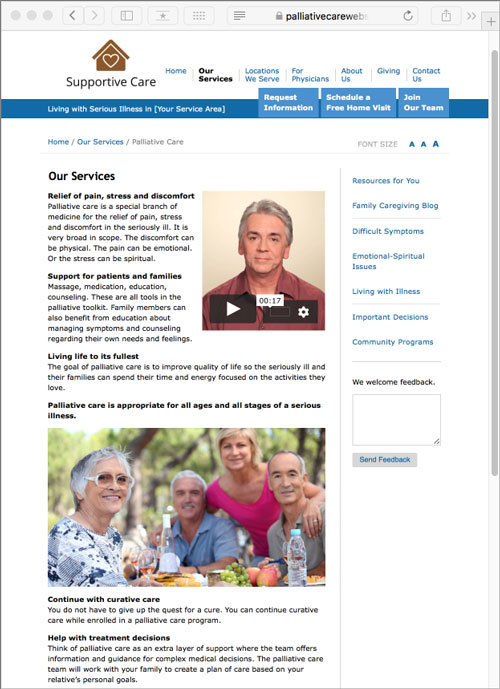
When explaining palliative care, it’s tempting to compare and contrast it to hospice. But research from the Center to Advance Palliative Care (CAPC) indicates that defining palliative care in the context of how it differs from hospice only muddies the waters. Palliative care programs need to stand on their own and define themselves independently.
How to describe palliative care?
The job of the marketing team is admittedly challenging. “Palliative” is not a word in common usage. Add to this the fact that “to palliate” means “to comfort” and it becomes even trickier. Hospice services are often described as “comfort care” and much of what hospice does is palliation.
And then there’s the competition
Beyond differentiating your palliative care service from your hospice service, you also need to describe your program in a way that highlights the unique offerings that make it different from any competing palliative care programs in your area.

CAPC’s generic definition
After testing a variety of messages for describing palliative care, here is the wording that CAPC found to be most favorably received:
- Palliative care is specialized medical care for people with serious illnesses.
- This type of care is focused on providing patients with relief from the symptoms, pain, and stress of a serious illness.
- The goal is to improve quality of life for both the patient and the family.
- Palliative care is provided by a team of doctors, nurses and other specialists who work with a patient’s other doctors to provide an extra layer of support.
- Palliative care is appropriate at any age and at any stage in a serious illness, and can be provided together with curative treatment.

Key features of your message
Although many of these features could also be used to describe hospice, there are enough nuances that it’s worth looking at why these tested out so positively for palliative care.
- “Serious illness”. According to a 2011 national public opinion poll, the term “serious illness” is the most effective for palliative care. It keeps concepts like “terminal illness” and “end-of-life” enough at bay to remove the stigma and fear associated with hospice. “Serious illness” also seems to correlate to a layperson’s description of a family member’s last 18 months—the ideal timeframe for palliative services. For the general public and for providers, “serious illness” is preferable to “advanced illness” which is too often associated with end-stage conditions and gets too near the domain of hospice.
- “Symptoms, pain and stress”. The point here is to describe relief for emotional and physical distress, while also clarifying for providers that your team has expertise and a focus separate from addressing the curative treatments for the condition.
- “Quality of life for both the patient and family”. Again, hospice could make the same claim. But emphasizing the patient and family as the unit of care helps get the attention of family members (key decision-makers) even if they aren’t quite sure yet what “palliative” means.
- “…work with the patient’s other doctors to provide an extra layer of support”. By taking a secondary place and defining palliative care as an “extra layer of support,” families—and referring doctors—can be reassured that the existing physicians are still the primary providers and your team is serving more of a consulting role.
- “…any age and any stage of a serious illness”. Without saying “you don’t have to be terminal,” this wording clarifies that important distinction. Also implied for physicians, there is no need for prognostication. No more 6-month certification. Furthermore, the “any age” component helps overcome resistance that younger people with serious conditions may experience if they equate palliation solely with the elderly.
Creating your own definition
 You don’t need to use CAPC’s exact phrasing. You can certainly create your own, and will have to if a competitor has already used it. But learning from CAPC’s research, you want to be sure you:
You don’t need to use CAPC’s exact phrasing. You can certainly create your own, and will have to if a competitor has already used it. But learning from CAPC’s research, you want to be sure you:- Paint a picture of how much joyful living is possible once distressing symptoms and emotions have been addressed.
- Display pictures and text that make it clear family members are included in the palliation.
- Emphasize that palliative care can be provided alongside curative care.
- Reinforce that palliative care is appropriate for all ages and all stages of a serious illness.
- Reassure patients and providers that their regular doctors remain in charge.
Beyond that, you need to differentiate from competitors.
Focus on these four elements:
- Services – What care is provided and under what circumstances? Do you offer disease-related bundles, for instance, Living with CHF, Living with COPD, Living with Cancer?
- Location – Is your program available in the hospital? At home? In skilled nursing facilities?
- Personnel – Members of the team. This may be a key differentiator. For example, does your palliative care team include volunteers for weekly family respite?
- Benefits – Which audience are you trying to reach? The benefits to the patient and family are quite different from those felt by your referrers, or even any hospital executives you may be wooing for a collaboration. How you describe your program and the problems you solve will depend on who you’re trying to reach in your campaign and the gaps perceived by that audience.
Want a Webmaster who knows your business?
There are many Web developers out there who can help you design a website. If you prefer the insights of a webmaster who understands the difference between retail vs. medical services, as well as the specific nuances of marketing palliative care, give me a call at 707-477-0700 (Pacific time). Or email me at tasha@elderpagesonline.com. I’d be happy to talk about your program and how we can help you promote it to maximum effect.


